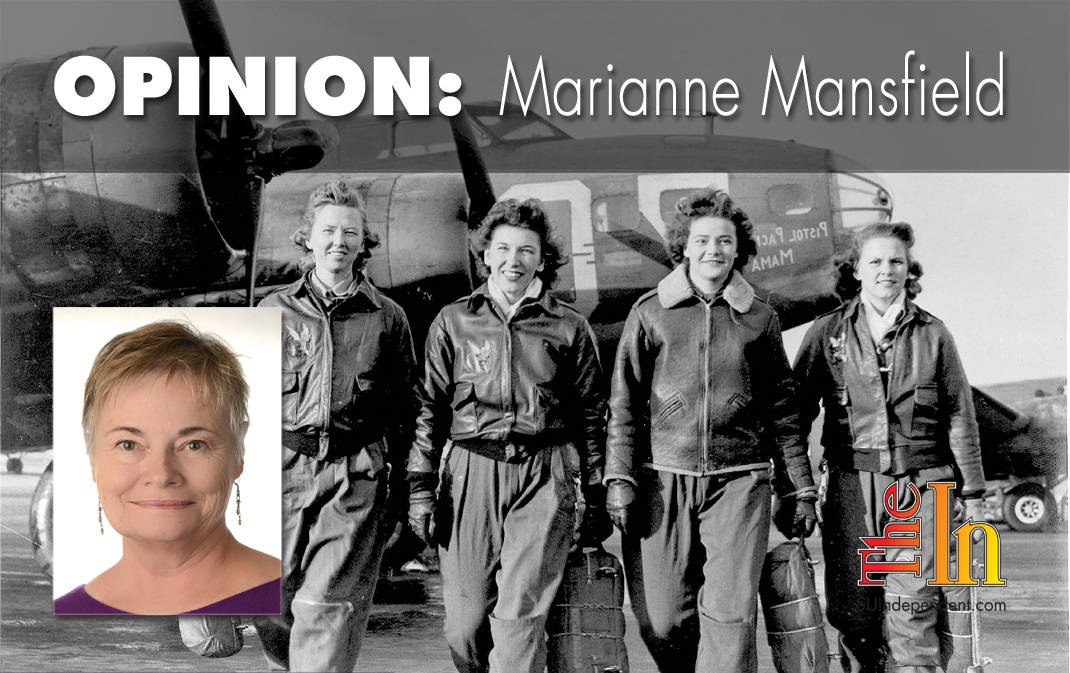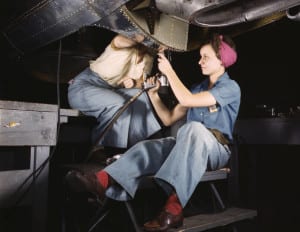 Fifinella was a female gremlin designed by Walt Disney for a proposed film from Roald Dahl’s book, “The Gremlins.” During World War II, the Women Airforce Service Pilots (WASP) asked permission to use the image as their official mascot, and the Disney Company granted them the rights. Ironically, it took the administration of Arlington Cemetery another 70 years to grant WASP the right to be interred with their combat peers.
Fifinella was a female gremlin designed by Walt Disney for a proposed film from Roald Dahl’s book, “The Gremlins.” During World War II, the Women Airforce Service Pilots (WASP) asked permission to use the image as their official mascot, and the Disney Company granted them the rights. Ironically, it took the administration of Arlington Cemetery another 70 years to grant WASP the right to be interred with their combat peers.

House lawmakers overwhelmingly approved legislation on March 22, allowing a group of female World War II military pilots to be interred at Arlington National Cemetery and reversing Army officials’ orders. On the surface this seems overdue, but ultimately it was the righting of a long-standing wrong. Of course, WASP should have the right to interment at any national military burial place.
Like an onion, though, there are many layers to this sad story, and to understand the pervasiveness of sexism in our country’s history, one needs to peel back the layers one by one.
First, the facts: During World War II, women in uniform took office and clerical jobs in the armed forces in order to free men to fight. Over 25,000 women applied to be trained as military pilots. Of those, 1,100 were accepted. These women served at more than 100 posts under the aegis of the Army Air Force. Their duties included ferrying airplanes to combat destinations, training combat pilots, and towing airborne targets. Thirty-eight died in line of duty, all accidents.
Despite their proximity to actual combat, their service was designated as civilian service. Herein, a layer of the onion rips and peels away.
WASPs were trained as military pilots, flying every plane in the U.S. arsenal. The program was considered experimental to determine the value and skill of women to serve their nation’s military aviation needs. Due to the extreme urgency and need, the WASPs were organized as civilian volunteers while awaiting the necessary congressional action for their militarization. They were pressed immediately into service, first as the Women’s Auxiliary Ferrying Squadron (WAFS) and the Women’s Flying Training Detachment (WFTD), and then combined as WASP. The urgency, it seems, was that young men were needed in combat. Young women were drawn into all sorts of service to free up men to fight.
The WASP served as civilians for the USAAF from September 1942 until their disbandment in December 1944. Although most WASPs expected to be brought into the USAAF, they missed by a narrow congressional vote after an ugly public battle in the summer of 1944.
According to Katherine Sharp Landdeck, associate professor of history at Texas Woman’s University, “It was a very controversial time for women flying aircraft. There was a debate about whether they were needed any longer.” The war appeared to be ending. Flight training programs were closing down, and male civilian instructors were losing their positions. Fearing the draft and being assigned to the ground force Army, the male instructors lobbied, successfully it seems, for the women’s jobs.
“It was unacceptable to have women replacing men. They could release men for duty — that was patriotic — but they couldn’t replace men,” Landdeck says.
 Did you smell it? Another layer of the onion just fell away. Women were expected to give up their careers so that their male counterparts could stay on. And most did. Remember, this was 1944. Some women who were abandoned by WASP sought flying jobs with the airlines — not the major ones, however — and some settled for positions as “hostesses” just to remain in the air. The rest returned home, along with their Rosie the Riveter sisters.
Did you smell it? Another layer of the onion just fell away. Women were expected to give up their careers so that their male counterparts could stay on. And most did. Remember, this was 1944. Some women who were abandoned by WASP sought flying jobs with the airlines — not the major ones, however — and some settled for positions as “hostesses” just to remain in the air. The rest returned home, along with their Rosie the Riveter sisters.
Fast forward to 1977 when the Air Force made the monumental error of claiming that women were going to begin flying military aircraft for the very first time. Former WASP who knew better banded together and stormed Congress, demanding that their service be recognized as “military.” They found an unlikely champion in Barry Goldwater, who had also ferried aircraft in World War II. Finally, Congress passed Public Law 95-202, which directed the Secretary of Defense to certify that the WASP service was “active military service.” WASPs were issued DD-214s, separation papers indicating that the bearers had honorably fulfilled their military commitment.
While some have alleged that the push to militarize the service of the WASP was simply to provide them with access to veterans’ benefits, that has been refuted. Women who led the fight in 1977 claimed, and believably so, that they simply wanted recognition of the patriotic role they had played. Women fighting to have their work recognized for its contribution to society … it has a familiar ring to it, doesn’t it?
Next, in 2002 Arlington National Cemetery approved WASP group members for military honors, including burial.
But the battle wasn’t over yet. In late 2015, in a move that smacks of bureaucratic doublespeak at its finest, the then-Army Secretary declared that in 2002 the Arlington Cemetery officials had committed a major booboo. They, according to the then-Secretary, were not authorized to make a pronouncement about who gets in and who doesn’t, because the cemetery follows Army policies, not Veterans’ Affairs rules.
By now, the stink of this mess should be making your eyes drip with tears. All of this was over 38 women who by all counts were motivated by nothing more than simple patriotism. They stepped up and learned to fly military planes in the early 1940s. They lived in barracks, ate at the mess, and put their lives in danger.
And it takes an act of Congress to allow some of those 38 women to have urns containing their ashes placed in the a memorial nave at Arlington National Cemetery.
This is a travesty, at the heart of which is a sad but pervasive misogyny. It didn’t come to life in the early ’40s and obviously hasn’t been slain today.
Witness the boorishness of Raymond Moore, Indian Wells women’s tennis director, on March 20, 2016. He suggested that women players should “get down on their knees” to thank some of their male contemporaries because those men have “carried the sport.” The implication is bad enough; the visual image is even worse.
Is there a grain of truth in what he might have been intending to say? Of course. It is the sad fact that women’s salaries rise disproportionately with — but in a direct relationship to — men’s salaries in most industries, especially sport. Women, even today, are forced to peg their worth in part as it compares to a man’s. Some would argue this is changing. I would shout, “Not fast enough!”
There was also probably a grain of truth in the WASP circumstances. Women were pressed into service in a hurry, because during World War II only men were considered suitable for combat service — a “fact” since resoundingly disproven but held to be true at that time, nonetheless. What evolved, however, was evil spun out of control. It took an act of Congress to address what had sprung from a simple grain of truth gone awry.
And that is why minority groups feel a driving need to be ever vigilant about language, about appearance, about nuance. Grains of truth have a way of getting fertilized in this culture, and they can often produce most foul-smelling results.




Yes. I remember wanting to fly military aircraft in the 70’s. Basically, I was told that my vocational tests indicated that I should be a teacher or secretary. Ha! I am not a big “kid” person and my typing skills are not that great. However, I fly a plane pretty well. Go figure…
Thank you for writing this, my grandmother Elaine Harmon and all WASP deserve the choice of Arlington. You explain well why I am still fighting for her 70 years after her service.